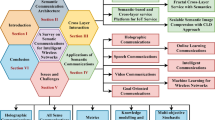Abstract
A multihop mobile wireless network can be a collection of wireless mobile nodes forming a temporary network without the aid of any established infrastructure or centralized administration. Mobile nodes communicate with each other using multihop wireless links. Each mobile node in the network also acts as a router, which forwards data packets to other nodes. A main challenge in the design of this mobile network is the development of dynamic routing protocols that can efficiently find routes between two communicating nodes that often change the network topology drastically and unpredictably. All communications between the nodes inside the mobile network and the global Internet must be maintained, although the mobile router (MR) connecting the other mobile network to the global Internet must change their address; and mobile nodes suffer from end-to-end delay and handoff delay. That is to say, hereafter the packets sailing for the mobile node would not be routed directly for the destination, but will always make a detour by way of HA to the target node. In this paper, we suggest Information-based Connection Algorithm that adds keyword management method in order to resolve such a problem, simulations are carried out with NS-2 for performance evaluation. The results of the simulations show an improvement on throughput and handoff delay, and consequently the QoS improvement.















Similar content being viewed by others
References
Lach, H.-Y., Janneteau, C., & Petrescu, A. (July 2003). Network Mobility in beyond-3G systems, Communications Magazine. IEEE.
Devarapali, V., Wakikawa, R., Petrescu, A., & Thubert, P. (2005). Network Mobility (NEMO) Basic Support Protocol. RFC3962.
Ng, C., Paik, E., & Ernst, T. (August 2005). Analysis of Multihoming in Network Mobility Support, draft-ietf-nemo-multihoming-isuues-02.txt.
Lamsel, P. (2005). Network Mobility, research seminar on hot topics in Internet protocols.
Ernst, T., & Lach, H.-Y. (August 2005). Network Mobility Support Terminology, draft-ietf-nemo-terminology-03.txt.
Ernst, T. (August 2005). Network Mobility Support Goals and Requirements, draft-ietf-nemo-requirement-04.
Kupiainen, E. (February 2003). Hierarchical Mobile IPv6 Mobility Management.
http://www.ittc.ku.edu/∼ananth/845.html, Beacon Routing in Active Network.
Mark, A., & Miller, P. E. (1998). Inside Secrets SNMP Managing Internetworks. SamGakHyung Press.
Wang, Y., Chen, W., Ho, J. S. M. (1997). Performance analysis of adaptive location management for mobile IP, Technical Report 97-CSE-13. Southern Methodist University.
Hagen, S. (July 2002). IPv6 Essentials. O’reilly.
The CMU Monarch Project’s Wireless and Mobility Extension to ns. The CMU Monarch Project (August 1999). Snapshot release 1.1.1.
Widmer, J. (May 2000). Network simulations for A Mobile Network Architecture for vehicles, Technology Report TR-00-009. International Computer Science Institute.
Author information
Authors and Affiliations
Corresponding author
Rights and permissions
About this article
Cite this article
Ryu, SH., Baik, DK. Information-based connection algorithm for supporting QoS in nested mobility network. Wireless Netw 15, 773–789 (2009). https://doi.org/10.1007/s11276-007-0074-1
Published:
Issue Date:
DOI: https://doi.org/10.1007/s11276-007-0074-1




